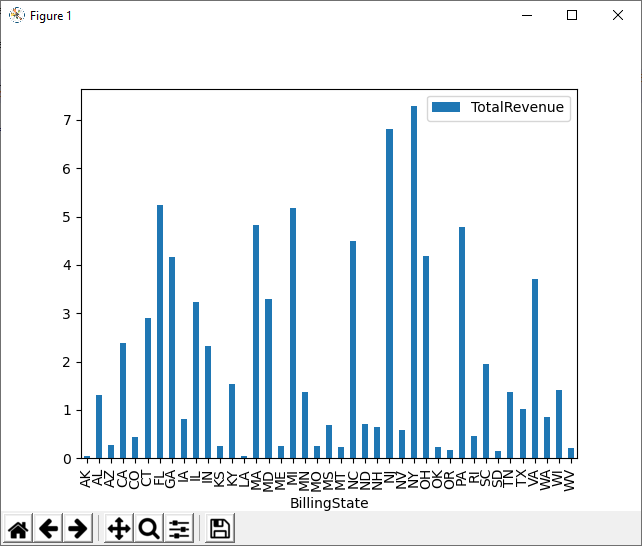Model Context Protocol (MCP) finally gives AI models a way to access the business data needed to make them really useful at work. CData MCP Servers have the depth and performance to make sure AI has access to all of the answers.
Try them now for free →How to Visualize AlloyDB Data in Python with pandas
Use pandas and other modules to analyze and visualize live AlloyDB data in Python.
The rich ecosystem of Python modules lets you get to work quickly and integrate your systems more effectively. With the CData Python Connector for AlloyDB, the pandas & Matplotlib modules, and the SQLAlchemy toolkit, you can build AlloyDB-connected Python applications and scripts for visualizing AlloyDB data. This article shows how to use the pandas, SQLAlchemy, and Matplotlib built-in functions to connect to AlloyDB data, execute queries, and visualize the results.
With built-in optimized data processing, the CData Python Connector offers unmatched performance for interacting with live AlloyDB data in Python. When you issue complex SQL queries from AlloyDB, the driver pushes supported SQL operations, like filters and aggregations, directly to AlloyDB and utilizes the embedded SQL engine to process unsupported operations client-side (often SQL functions and JOIN operations).
Connecting to AlloyDB Data
Connecting to AlloyDB data looks just like connecting to any relational data source. Create a connection string using the required connection properties. For this article, you will pass the connection string as a parameter to the create_engine function.
The following connection properties are usually required in order to connect to AlloyDB.
- Server: The host name or IP of the server hosting the AlloyDB database.
- User: The user which will be used to authenticate with the AlloyDB server.
- Password: The password which will be used to authenticate with the AlloyDB server.
You can also optionally set the following:
- Database: The database to connect to when connecting to the AlloyDB Server. If this is not set, the user's default database will be used.
- Port: The port of the server hosting the AlloyDB database. This property is set to 5432 by default.
Authenticating with Standard Authentication
Standard authentication (using the user/password combination supplied earlier) is the default form of authentication.
No further action is required to leverage Standard Authentication to connect.
Authenticating with pg_hba.conf Auth Schemes
There are additional methods of authentication available which must be enabled in the pg_hba.conf file on the AlloyDB server.
Find instructions about authentication setup on the AlloyDB Server here.
Authenticating with MD5 Authentication
This authentication method must be enabled by setting the auth-method in the pg_hba.conf file to md5.
Authenticating with SASL Authentication
This authentication method must be enabled by setting the auth-method in the pg_hba.conf file to scram-sha-256.
Authenticating with Kerberos
The authentication with Kerberos is initiated by AlloyDB Server when the ∏ is trying to connect to it. You should set up Kerberos on the AlloyDB Server to activate this authentication method. Once you have Kerberos authentication set up on the AlloyDB Server, see the Kerberos section of the help documentation for details on how to authenticate with Kerberos.
Follow the procedure below to install the required modules and start accessing AlloyDB through Python objects.
Install Required Modules
Use the pip utility to install the pandas & Matplotlib modules and the SQLAlchemy toolkit:
pip install pandas pip install matplotlib pip install sqlalchemy
Be sure to import the module with the following:
import pandas import matplotlib.pyplot as plt from sqlalchemy import create_engine
Visualize AlloyDB Data in Python
You can now connect with a connection string. Use the create_engine function to create an Engine for working with AlloyDB data.
engine = create_engine("alloydb:///?User=alloydb&Password=admin&Database=alloydb&Server=127.0.0.1&Port=5432")
Execute SQL to AlloyDB
Use the read_sql function from pandas to execute any SQL statement and store the resultset in a DataFrame.
df = pandas.read_sql("SELECT ShipName, ShipCity FROM Orders WHERE ShipCountry = 'USA'", engine)
Visualize AlloyDB Data
With the query results stored in a DataFrame, use the plot function to build a chart to display the AlloyDB data. The show method displays the chart in a new window.
df.plot(kind="bar", x="ShipName", y="ShipCity") plt.show()

Free Trial & More Information
Download a free, 30-day trial of the CData Python Connector for AlloyDB to start building Python apps and scripts with connectivity to AlloyDB data. Reach out to our Support Team if you have any questions.
Full Source Code
import pandas
import matplotlib.pyplot as plt
from sqlalchemy import create_engin
engine = create_engine("alloydb:///?User=alloydb&Password=admin&Database=alloydb&Server=127.0.0.1&Port=5432")
df = pandas.read_sql("SELECT ShipName, ShipCity FROM Orders WHERE ShipCountry = 'USA'", engine)
df.plot(kind="bar", x="ShipName", y="ShipCity")
plt.show()

